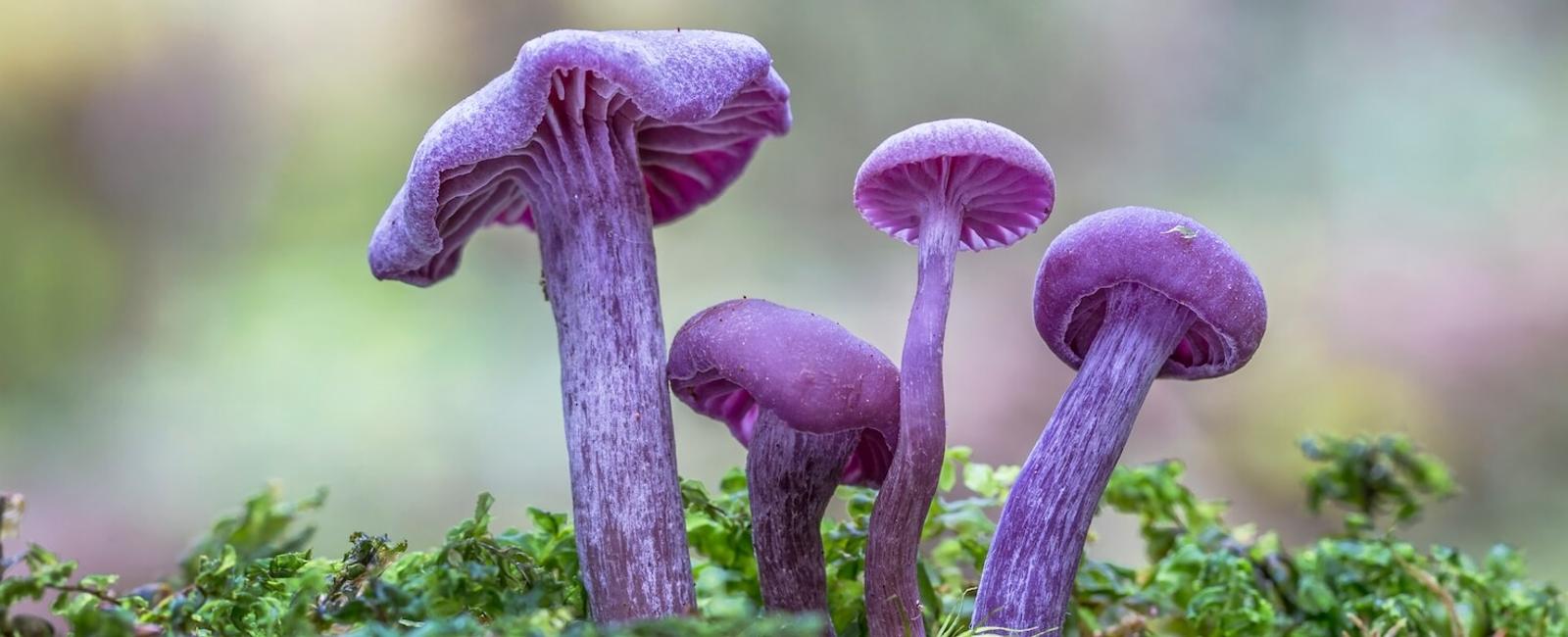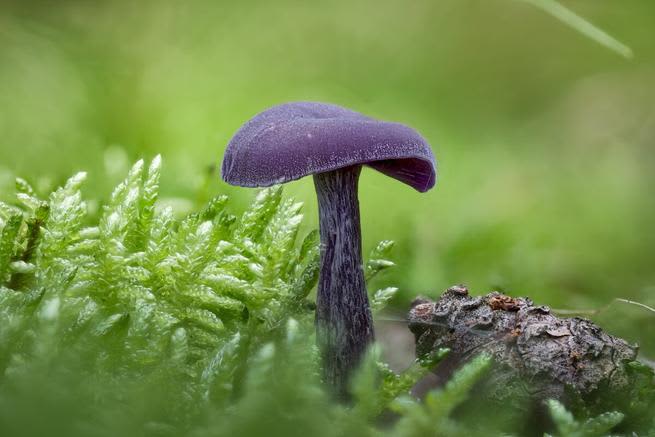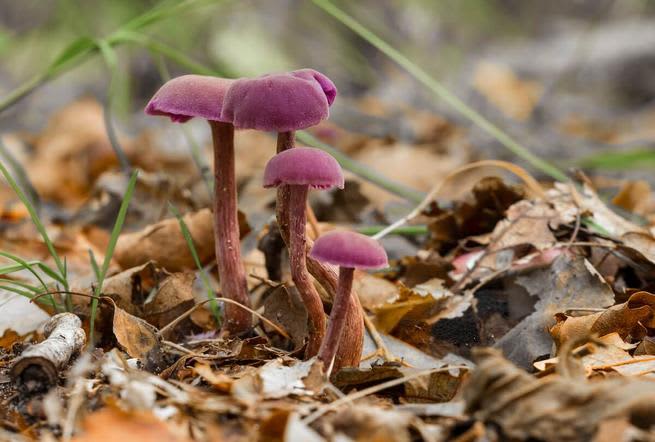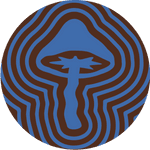

When it comes to eye-catching mushrooms, the small and enchanting laccaria amethystina is certainly one to know. This diminutive shroom dots the forest floor and is often hidden amongst the leaf litter, but its vivid shade of purple amethyst is nothing short of magical.
Learn more about laccaria amethystina, including where it grows, its colorful history, potential health benefits, and much more.
What are laccaria amethystina mushrooms?
Laccaria amethystina mushrooms are edible mushrooms that go by the common name of amethyst deceiver. The name laccaria comes from the Italian word “lacca,” meaning lacquer, while amethystina, derived from the Latin “amethystus,” is used as a signifier of its color.
A mycorrhizal mushroom, laccaria amethystina mushrooms form symbiotic relationships with other plants around them, primarily deciduous and coniferous trees (1).
The taxonomy for Laccaria amethystina is as follows:
Kingdom: Fungi
Phylum: Basidiomycota
Class: Agaricomyetes
Order: Agaricales
Family: Hydnangiaceae
Genus: Laccaria
Species: L. amethystina
What do laccaria amethystina mushrooms look like?

Laccaraia amethystina mushrooms look similar to other laccaria mushrooms, specifically laccaria laccata and laccaria bicolor, although laccaria amethystina is a stunning deep purple color instead of brownish pink.
These mushrooms have caps measuring up to an inch and a half across. Young laccaria amethystina shrooms have convex or globose caps that flatten as they mature and develop wavy edges. Laccaria amethystina’s caps may also have a central depression, depending on the mushroom, and they have a white spore print.
Young mushrooms are a beautiful deep purple color, often fading with age. It’s not unusual to see laccaria amethystina mushrooms fade into a buff or white color the older they are. And their gills follow a similar pattern: a deep purple fading to lilac with maturation (1).
Their color can occasionally be affected by weather conditions. An exceptionally wet day can cause their color to fade, making accurate identification a little trickier (2).
Psst: Laccaria amethystina could be confused with other similar species. Depending on its growth stage, this mushroom could be confused with laccaria amethysteo-occidentalis, Mycena pura (lilac blossom mushroom), purple Cortinarius, or the lilac fibrecap. Lilac fibrecaps are deadly, so proper mushroom identification is crucial (1).
Where do laccaria amethystina mushrooms grow?
Expect to find these mushrooms in deciduous and coniferous forests in North America, Central America, South America, Europe, and Asia (3). The growing season for laccaria amethystina is from summer to autumn (1).
Historical and traditional use of laccaria amethystina mushrooms

Unlike other medicinal mushrooms that have been historically well-documented like reishi, chaga, turkey tail, and lion’s mane), we don’t have much information about laccaria amethystina and how it may have been used in traditional medicine.
Fortunately, we do know a bit about its more modern history. William Hudson, an English botanist and apothecary, first described laccaria amethystina in 1778 as Agaricus amethystinus. Its current name, laccaria, was bestowed upon it by Mordecai Cubitt Cooke, an English botanist and mycologist, in 1884. Mycology was still an emerging field, and it would take the advent of modern technology for us to learn the full extent of what makes fungi unique (3).
Health benefits of laccaria amethystina mushrooms
Laccaria amethystina isn’t as well studied as other mushrooms. As such, we can’t definitively comment on the health benefits of consuming laccaria amethystina.
These mushrooms likely have similar health benefits as other mushroom species. They may have high amounts of antioxidants, beta-glucan, B vitamins, copper, and potassium (4).
What we know from the limited research available is that laccaria amethystina absorbs significant amounts of arsenic from the local environment (5), so we recommend being mindful of consuming these mushrooms and where they’ve been harvested.
Ethically wildcrafting laccaria amethystina mushrooms

Ready to head out in search of some laccaria amethystina specimens? Before you do, learning the difference between foraging and wildcrafting mushrooms is essential. While foraging may seem like a synonym for wildcrafting, there are some notable differences.
Foraging is often used as a general term for gathering mushrooms and other wild foods such as herbs, plants, nuts, berries, and seeds. On the other hand, wildcrafting specifically refers to harvesting local resources for medicinal needs. An essential distinction between the two is the mindful approach to wildcrafting, which considers the short- and long-term consequences that harvesting resources has on the local environment.
Learning the local area
Before you set out for an afternoon of harvesting mushrooms, learn about the area you plan to explore. Research whether you need any special permits or permissions before picking laccaria amethystina mushrooms. Another aspect of learning about the local area involves familiarizing yourself with any threatened or endangered mushroom species and potentially dangerous lookalikes.
Some toxic mushrooms look just like edible mushrooms, making proper mushroom identification critical. Consult a field or mushroom guide to help with identification. Always check with a mushroom expert if you aren’t sure what you’ve gathered is safe.
Mushroom anatomy and proper harvesting
An essential aspect of properly harvesting mushrooms begins with understanding mushroom anatomy. Mushrooms have two basic parts to their anatomy: a fruiting body and mycelium. A mushroom’s fruiting body is what we see growing above ground and what winds up neatly packed in the supermarket.
The mycelium is what exists below ground. The mycelium is a vast communication network composed of thread-like filaments called hyphae, where mushrooms exchange electrical impulses about their environment. These impulses carry information such as changing weather conditions, nearby predators, and even exchange nutrients.
When you’re ready to harvest your mushrooms, bring the appropriate tools. Do your best to keep the mycelium intact whether you gently twist your mushrooms free from the soil or cut them carefully at the base. Mindful harvesting makes it possible for mushroom populations to regenerate season after season.
Ecosystem preservation
Overharvesting leads to imbalances in a local ecosystem that can take years or even decades to recover from. Gather only what you need when you’re out hunting for laccaria amethystina (or any wild mushroom).
One strategy you can experiment with is making a spore print from your harvested mushrooms. Exactly what it sounds like, a spore print can be used to cultivate your own mushrooms at home, making it a sustainable option for preserving local ecosystems.
How can you enjoy laccaria amethystina mushrooms?

While laccaria amethystina mushrooms are edible, there isn’t necessarily a consensus around their flavor. Some people find it appealing, others not so much. Their stems are tough and fibrous, so it’s often only the caps that are used in cooking. Also, laccaria amethystina’s vibrant coloring fades when cooked, turning a dark gray-black (1).
When you’re ready to start experimenting in the kitchen, here are some of our favorite wild mushroom recipes for you to explore.
Buttered mushroom pasta
Craving something full of flavor and easy to whip up in the kitchen? This herby buttered wild mushroom tagliatelle pasta ticks all the boxes. Ready in 30 minutes, this recipe combines garlic with fresh herbs like thyme, basil, sage, and cheese for a meal you can make with pantry staples. It’s equally elegant for guests or a cozy night on the sofa.
Roasted mushroom salad
Whether you’re looking for a side dish or a snack you can reach for all week, this roasted mushroom salad is a must. Wild mushrooms, garlic, olive oil, red wine vinegar, and fresh parsley come together for an all-around simple and delicious recipe that couldn’t be easier. Prep your mushrooms, and then sit back and relax while they roast in the oven.
Cream of mushroom soup
No need to keep a can of the red and white stuff in your pantry with this cream of mushroom soup recipe. Only 10 minutes of prep and a 20-minute cooking time means you can have this dinner on the table in under an hour. Straightforward, simple to make, and brimming with umami flavor, we’re sure this recipe will become a favorite.
Laccaria amethystina: A vibrant gem of the forest floor
A stunning mushroom, laccaria amethystina is an expectedly beautiful find on the forest floor. And with so few mushrooms with such a striking hue, you’re sure to notice it if you get the chance to see it.
Still craving mushrooms? Be sure to keep up with all things mushroom on shroomer, where you’ll learn more about identification and all the latest breakthroughs and discoveries on functional and psychedelic mushrooms.
References
- “Foraging Guide Amethyst Deceiver | UK Foraging.” n.d. Foraging Course Site. https://www.foragingcoursecompany.co.uk/foraging-guide-amethyst-deceiver
- Harris, J C. 2015. “Plenty of Purple – The Amethyst Deceiver.” The Mushroom Diary - UK Wild Mushroom Hunting Blog. September 23, 2015. https://www.mushroomdiary.co.uk/2010/10/amathyst-deceiver/
- “Amethyst Deceiver.” n.d. Project Noah. https://www.projectnoah.org/spottings/7497597
- Goldman, Rena. 2017. “Are Mushrooms Good for You?” Healthline. October 12, 2017. https://www.healthline.com/health/food-nutrition/are-mushrooms-good-for-you
- “Laccaria Amethystina.” n.d. Science Direct. Accessed October 11, 2023. https://www.sciencedirect.com/topics/agricultural-and-biological-sciences/laccaria-amethystina.


